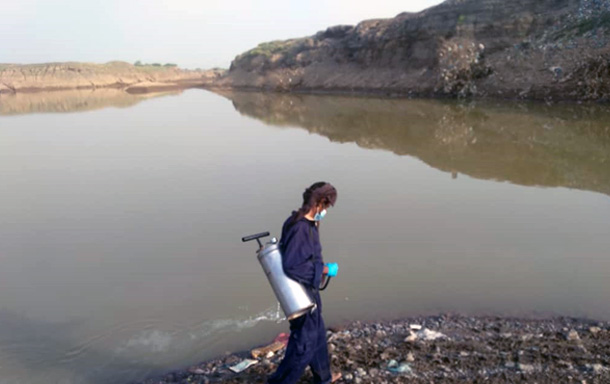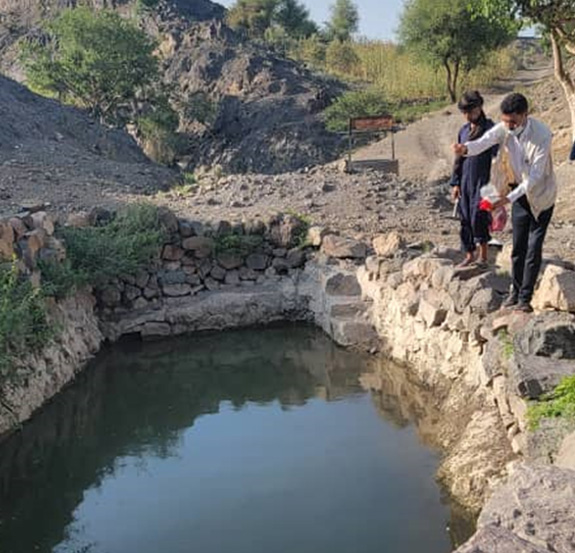 Some areas require heavy equipment to clear mosquito breeding sites. Photo credit: National Malaria Control Programme02 December 2024, Sana’a, Yemen – In early August, heavy rains caused torrential floods across many regions of Yemen, severely damaging infrastructure and inundating streets and homes.
Some areas require heavy equipment to clear mosquito breeding sites. Photo credit: National Malaria Control Programme02 December 2024, Sana’a, Yemen – In early August, heavy rains caused torrential floods across many regions of Yemen, severely damaging infrastructure and inundating streets and homes.
Poor sanitation has heightened the risk of waterborne diseases. Stagnant water from the floods created breeding sites for mosquitoes, increasing the risk of malaria and dengue fever outbreaks, while reduced access to clean water led people to store available supplies in containers inside their homes, creating additional sites for vector breeding.
Yemen is among 6 countries in the Eastern Mediterranean region with areas of high malaria transmission and accounts for the majority of malaria cases in the Arabian Peninsula. The World Malaria Report estimates that more than 21 million people in Yemen are at risk of malaria. Dengue fever, which overlaps with malaria in endemic areas, is also a major public health problem.
Since the beginning of 2024, Yemen has reported 1 051 287 suspected malaria cases and 13 739 suspected cases of dengue fever. Climatic, geographic and socioeconomic factors make the western coastal areas particularly susceptible and recent weather fluctuations, including rains, have contributed to the spread of vector-borne diseases, endangering vulnerable communities.
Supported by European Civil Protection and Humanitarian Aid Operations (ECHO), the World Health Organization (WHO) collaborated with the Yemeni Ministry of Public Health and Population and the National Malaria Control Programme to conduct a larval spraying campaign from 19 to 24 September.
Together with local authorities and community members, 40 teams participated in the campaign, benefiting over 4 million people in the governorates of Al-Mahwit, Amran, Hajja, Hodeidah and Sana’a. Areas that contain mosquito breeding sites, including swamps, ponds, the banks of valleys, open reservoirs and pits, were prioritized for intervention.
An initial survey identified 4664 villages and valleys for possible intervention out of which 1160 areas were confirmed as positive breeding environments. The Hodeidah governorate had the highest concentration, accounting for 48% of all targeted areas.
 Management of a mosquito breeding site using an insect growth regulator in Tehama region. Photo credit: National Malaria Control ProgrammeOf the positive mosquito breeding sites, 58% were natural and 42% per cent human-made. The proportion of human-made sites increases annually, often due to the building of water barriers and the draining of valley water for commercial sand extraction.
Management of a mosquito breeding site using an insect growth regulator in Tehama region. Photo credit: National Malaria Control ProgrammeOf the positive mosquito breeding sites, 58% were natural and 42% per cent human-made. The proportion of human-made sites increases annually, often due to the building of water barriers and the draining of valley water for commercial sand extraction.
The campaign also identified mosquito breeding sites in flood-affected areas which were then controlled by permanent removal and drainage or managed through the use of insect growth inhibitors. Permanent breeding sites were subjected to continuous monitoring and sectoral coordination strengthened through community initiatives and collaboration with relevant local authorities.
“Participatory action, involving local communities and various sectors, is crucial in controlling outbreaks. This campaign exemplified successful collaboration, with local authorities and community initiatives playing a key role in the planning and execution, covering a wide geographical area,” said WHO Representative and Head of Mission to Yemen Dr Arturo Pesigan.
“Continued cooperation with local authorities and community members is essential to foster their role in controlling breeding sources and preventing new ones, protecting communities and leaving no one behind.”
The ongoing conflict in Yemen has severely impacted communities across the country, exacerbating humanitarian crises and health challenges. The health care system in Yemen, which has one of the highest disease prevalence rates globally, is overwhelmed, and poverty and harsh living conditions further endanger the health and well-being of millions of people.


